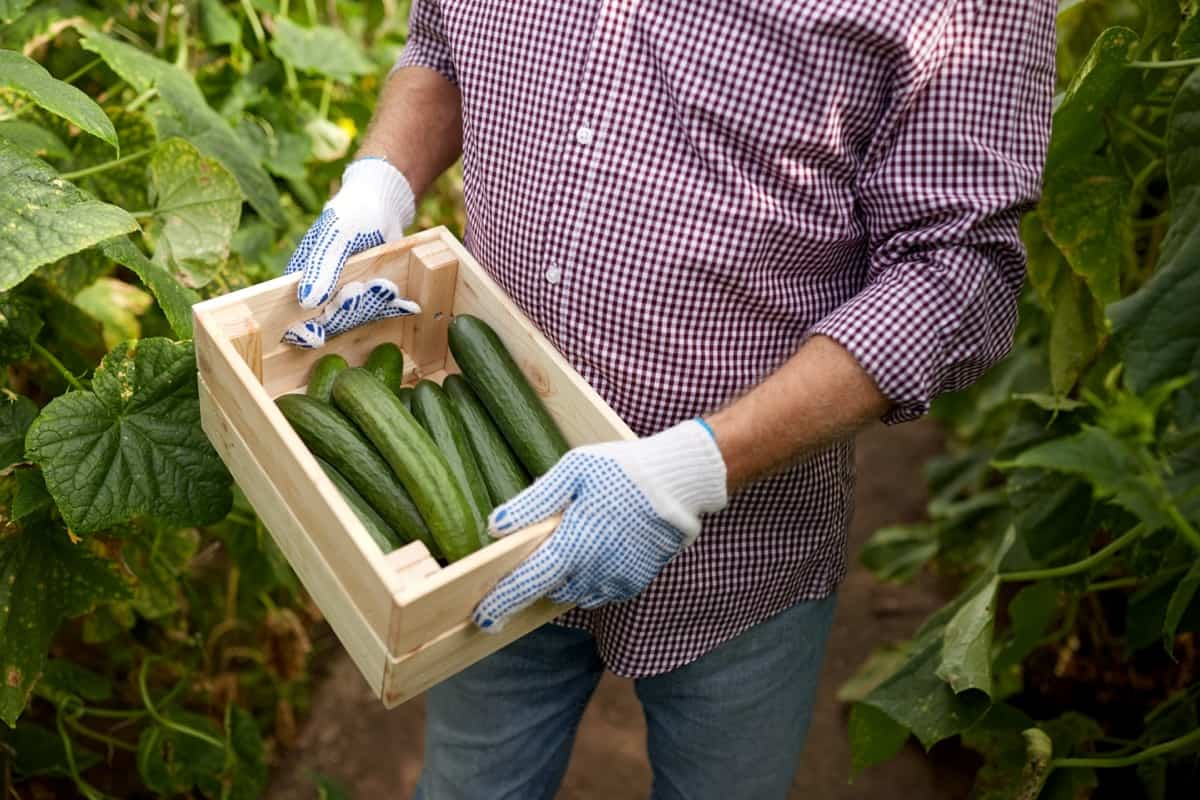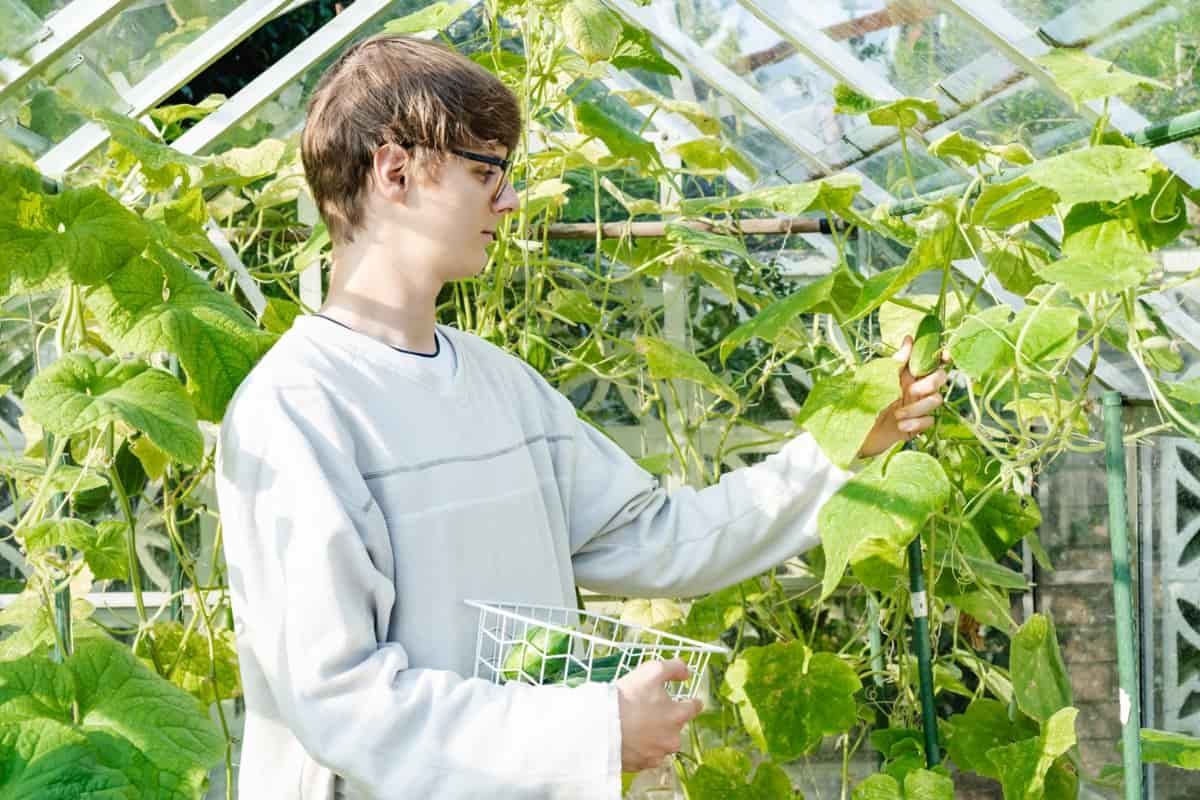Hydroponic cucumber farming in a greenhouse offers numerous advantages over traditional soil-based cultivation. These include efficient use of water, reduced need for pesticides, and better control over growing conditions. Below we learn about Hydroponic cucumber farming, hydroponic cucumber problems, hydroponic cucumber fertilizer formula, and key rules from scratch.

Hydroponic Cucumber Farming in a Greenhouse
Choose the Right Greenhouse
- Be spacious enough to accommodate the desired number of plants and equipment.
- Offer optimal light exposure, with at least 6-8 hours of sunlight daily.
- Have temperature and humidity control systems in place.
- Provide adequate ventilation to prevent excessive heat and maintain good air circulation.
- Be built with durable materials that can withstand harsh weather conditions.
- Include a convenient access point for water and electricity.
Remember, the size of the greenhouse will depend on your budget, space constraints, and future expansion plans. It’s also essential to consider local regulations and building codes before setting up your greenhouse.
Choose the Hydroponic System
Selecting the right hydroponic system is critical for growing healthy, productive cucumber plants. The most popular hydroponic systems for cucumber farming are Nutrient Film Technique (NFT), Aeroponics, and Dutch Bucket systems. Each has its advantages and disadvantages. Evaluate each system based on factors such as initial investment, maintenance requirements, and suitability for cucumber growth before deciding.
- Nutrient Film Technique (NFT): A thin film of nutrient-rich water continuously flows over the plant roots in this system. NFT is known for its efficiency and ease of use but may not be suitable for large cucumber plants, as they can become too heavy for the channels.
- Dutch Bucket System: This system utilizes individual containers (buckets) filled with an inert growing medium (like perlite or coco coir) and a drip irrigation system. It’s ideal for growing large cucumber plants, providing ample support and room for root development.
Select the Right Cucumber Variety
- Socrates: A parthenocarpic variety is known for its high yield, disease resistance, and excellent taste.
- Tyria: Another parthenocarpic variety with similar characteristics to Socrates but with a slightly longer fruit.
- Corinto: A hybrid variety with good disease resistance and a high yield.
- When selecting the suitable cucumber variety for your hydroponic farm, consider fruit size, taste, yield, and disease resistance.
Prepare the Nutrient Solution
A well-balanced nutrient solution is essential for optimal cucumber growth. The solution should contain all the necessary macro and micronutrients, including nitrogen, phosphorus, potassium, calcium, magnesium, sulfur, and trace elements. You can purchase pre-mixed nutrient solutions designed for hydroponic cucumber cultivation or create your own by following a reliable recipe.
The pH of the nutrient solution should be between 5.5 and 6.5, and the electrical conductivity (EC) should be maintained between 1.8 and 2.5 mS/cm. Regularly test the nutrient solution to ensure it remains within the optimal range, and adjust the pH and EC levels as needed.
Establish a Proper Planting Schedule
Establish a staggered planting schedule for your hydroponic cucumber farm to ensure a continuous harvest. This means sowing seeds at regular intervals so that when one batch of plants reaches the end of their productive life, another is ready to take its place.
A typical planting schedule may involve sowing seeds every 2-4 weeks, depending on the specific cucumber variety and your farm’s size. Maintain a detailed record of your planting schedule, including the sowing date, germination date, and expected harvest time. This will help you plan for future plantings and track your farm’s productivity.
In case you missed it: How to Grow Yellow Cucumber (Dosakaya) in Home Garden: Pots, Backayrd, and Terrace

Monitor and Control Environmental Conditions
Consistent monitoring and control of environmental conditions within the greenhouse are crucial for optimal cucumber growth. Key factors to monitor and regulate include:
- Temperature: Maintain daytime temperatures between 70-75°F (21-24°C) and nighttime temperatures between 60-65°F (15-18°C). Excessively high or low temperatures can stress the plants and reduce yields.
- Humidity: Keep relative humidity between 50-70% to prevent mold, mildew, and pests. Use dehumidifiers, heaters, or ventilation systems to manage humidity levels.
- Light: Ensure your plants receive at least 6-8 hours of sunlight daily. During periods of low light, consider supplementing with artificial grow lights.
Train and Prune Cucumber Plants
Proper training and pruning of cucumber plants are essential to maximize yield and minimize disease risks. Training involves guiding the main stem of the cucumber plant onto a trellis, string, or another vertical support system. This helps promote vertical growth, ensures even light distribution, and makes harvesting easier.
Pruning involves removing excess foliage, side shoots, and non-fruiting branches to encourage the plant to focus its energy on fruit production. This increases yield and improves air circulation and light penetration, reducing the risk of disease and pest infestations.
Pest and Disease Management
Hydroponic systems generally have fewer pest and disease problems than soil-based cultivation, but it’s essential to maintain a proactive approach to prevent and treat any issues that arise. Maintain a regular inspection schedule to look for indicators of pests and diseases, and then use IPM tactics, including introducing beneficial insects, using biological controls, or applying targeted environmentally friendly pesticides.
Harvest and Post-Harvest Handling
Cucumbers are typically ready for harvest 50-70 days after planting, depending on the variety. Harvest cucumbers are typically 10-12 inches (25-30 cm) long when they reach the desired size. Use a clean, sharp knife or pruning shears to cut the fruit from the vine. A hydroponic cucumber plant can produce 15 to 25 fruits per plant over its entire growing season, typically around 12 to 16 weeks.
However, it is possible to achieve even higher yields under optimal conditions and with proper care. Some commercial growers have reported up to 40 fruits per plant in a single growing season. Proper post-harvest handling is crucial to maintain freshness and quality. Store harvested cucumbers at a temperature of 50-55°F (10-13°C) with a relative humidity of 90-95%. Avoid storing cucumbers near ethylene-producing fruits, which can cause premature ripening and spoilage.
In case you missed it: How to Grow Rosemary from Cuttings: A Complete Planting Guide

Conclusion
Starting a hydroponic cucumber farm in a greenhouse from scratch may seem daunting. Still, with careful planning and research, you can successfully establish a thriving and profitable cucumber farm.
- Feed Your Flock for Less: Top 10 Tips to Save on Chicken Feed
- Ultimate Guide to Ossabaw Island Hog: Breeding, Raising, Diet, and Care
- Hatching Answers: The Top 10 Reasons Your Chickens Aren’t Laying Eggs
- Eggs and Economics: Breaking Down the Cost of Raising Backyard Chickens
- Defend Your Greens: Proven Methods to Keep Iguanas Out of Your Garden
- Ultimate Guide to Cinnamon Queen Chicken: A Comprehensive Guide for Beginners
- Ultimate Guide to California Tan Chicken: Breeding, Raising, Diet, Egg-Production and Care
- Ultimate Guide to Marsh Daisy Chicken: Breeding, Raising, Diet, and Care
- 10 Types of Chicken Farming Businesses You Can Start for Profits